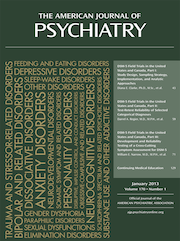DSM-5 Field Trials in the United States and Canada, Part III: Development and Reliability Testing of a Cross-Cutting Symptom Assessment for DSM-5
Abstract
Objective
The authors sought to document, in adult and pediatric patient populations, the development, descriptive statistics, and test-retest reliability of cross-cutting symptom measures proposed for inclusion in DSM-5.
Method
Data were collected as part of the multisite DSM-5 Field Trials in large academic settings. There were seven sites focusing on adult patients and four sites focusing on child and adolescent patients. Cross-cutting symptom measures were self-completed by the patient or an informant before the test and the retest interviews, which were conducted from 4 hours to 2 weeks apart. Clinician-report measures were completed during or after the clinical diagnostic interviews. Informants included adult patients, child patients age 11 and older, parents of all child patients age 6 and older, and legal guardians for adult patients unable to self-complete the measures. Study patients were sampled in a stratified design, and sampling weights were used in data analyses. The mean scores and standard deviations were computed and pooled across adult and child sites. Reliabilities were reported as pooled intraclass correlation coefficients (ICCs) with 95% confidence intervals.
Results
In adults, test-retest reliabilities of the cross-cutting symptom items generally were good to excellent. At the child and adolescent sites, parents were also reliable reporters of their children’s symptoms, with few exceptions. Reliabilities were not as uniformly good for child respondents, and ICCs for several items fell into the questionable range in this age group. Clinicians rated psychosis with good reliability in adult patients but were less reliable in assessing clinical domains related to psychosis in children and to suicide in all age groups.
Conclusions
These results show promising test-retest reliability results for this group of assessments, many of which are newly developed or have not been previously tested in psychiatric populations.



